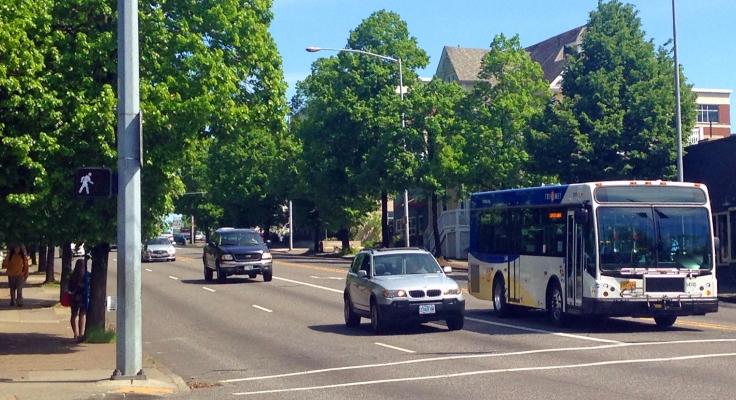Proposed Transit Investment Could Impact Affordability, Access in SE Portland Neighborhoods

New transit service often spurs new development. As transit makes an area more accessible, it becomes a more attractive place for investors to build. This new investment, however, can create serious housing problems for the very residents who depend most on transit: lower-income households and people of color.
The latest report from the NITC program, from a research effort led by Lisa Bates and Aaron Golub of Portland State University, studies the intended and unintended costs and benefits of a new transit investment on the diverse communities of East Portland, Oregon; many already under stress from existing development and gentrification pressures.
The report, Planning Ahead for Livable Communities Along the Powell-Division BRT: Neighborhood Conditions and Change, offers an analysis of the planning of a new transit infrastructure project in Portland, crossing several neighborhoods in different stages of gentrification along the Powell-Division corridor. Public transit use for commuting is higher in the study corridor than in surrounding areas, and car ownership in the corridor is far lower than the national average.
The research aims to improve the current understanding of the transportation access and housing impacts of a new Bus Rapid Transit (BRT) system and to shape the planning discussion to increase benefits and reduce harms for affected communities. Bates and Golub conclude that, on balance, the BRT project has positive potential for benefiting low-income residents and workers in the corridor.
Related research: Impacts of Bus Rapid Transit (BRT) on Surrounding Residential Property Values. This report, from NITC researcher Victoria Perk of the University of South Florida, shares results from this study of BRT's impacts on land uses and property values via a case study on Lane Transit District’s EmX BRT service in Eugene, Oregon.
For both transit and housing impacts, Bates and Golub concentrated on three questions:
1) How does the new transit service differentially affect specific populations of equity concern?
2) How does the new transit service differentially affect residents of neighborhoods across a spectrum of gentrification risk?
3) How does the new transit service differentially affect these populations depending on which kinds of neighborhoods they live in?
The study found that housing needs along the Powell-Division corridor are already substantial, even before construction of new transit infrastructure.
Powell-Division households are likely to be at least somewhat dependent on transit to get around, and are already significantly pressured by housing prices: households making 30–50 percent of the area’s median family income are the most housing cost-burdened (meaning they pay more than 30 percent of their monthly income on housing). Moreover, rental units affordable to that income range are very likely to be leased by higher-income households. Households that are already cost-burdened are more likely to be displaced by the rising housing costs that are expected to go hand-in-hand with redevelopment on the corridor.
For more detailed statistics on housing vulnerability for different populations along the Powell-Division study area, take a look at the housing analysis (section 3 of the final report). In it, Bates and Golub provide baseline information about neighborhood conditions that is important for planners to be aware of when considering ways to avoid housing displacement.
They found that the most important factor in predicting future neighborhood change is the overall trend of the neighborhood towards either gentrification or receiving displaced people and becoming lower-income. In fact, the current conditions and trend in the neighborhood have a larger magnitude of impact on housing affordability than the proposed transit project is projected to have.
To understand how the Powell-Division transit proposal will serve different populations, the researchers compared their travel needs with the transportation services delivered by the proposed investments. They examined the current commute patterns of residents and the potential new job locations that would be made more accessible by the new system.
The analysis of job and home locations revealed that the proposed transit improvements will well serve low-income residents who currently live and work along the corridor. Higher-income residents who live along the corridor will also be well served by the new system, as they will probably require, on average, fewer transfers to reach their final work destinations. Both groups stand to benefit from the investments.
By studying transit and housing together, researchers hoped to identify potential new neighborhood development and displacement effects from the transit project. However, they concluded that the already existing housing needs and displacement trends are a priority to consider first; there are already serious issues with the lack of affordable housing in the corridor.
These problems are particularly intense in communities of color, immigrant families, people with disabilities and extremely low-income households. It is possible that some of those problems will get worse with a new transit line, but the trends in the housing market show that those problems are already worsening without any new public investment.
However, this doesn’t mean that planners should take no responsibility for housing displacement in the area. The problem of housing vulnerability and lack of access to opportunity cannot be blamed on this project, and the project may have the potential to alleviate housing vulnerability and lack of access for some workers. Looking at the area through an equity lens, planners have the opportunity to use the new bus service plan as an opportunity to open a discussion about neighborhoods and their needs.
Paying close attention to existing affordable housing and the additional commuting needs of low-income workers in the corridor will leverage the project for positive benefits.
For more information, visit the project page or download the report.
